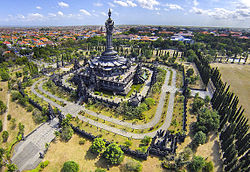Bajra Sandhi Monument
| Bajra Sandi Monument | |
|---|---|
 Aerial view of the Bajra Sandhi monument | |
 | |
| General information | |
| Type | Monument, museum |
| Location | Denpasar, Bali |
| Coordinates | 8°40′18″S 115°14′2″E / 8.67167°S 115.23389°E |
| Construction started | 1987 |
| Completed | 2001 |
| Opened | 2004 |
| Owner | Bali Government |
| Management | Bali Museum |
| Design and construction | |
| Structural engineer | Ir. Ida Bagus Yadnya[1] |
Bajra Sandhi Monument is a monument to the struggles of the Balinese people throughout history.[2] The monument is located in front of the Bali Governor's Office in Denpasar, Indonesia, on the island of Bali. The monument was built in 1987, and inaugurated by President Megawati Sukarnoputri on 14 June 2003.
Structure
[edit]The monument is rectangular, and follows the architectural principles of the "Tri Mandala." It consists of three parts:[2]
- Utama Mandala, the main building in the center of the monument
- Madya Mandala, the inner courtyard surrounding the Utama Mandala
- Nista Mandala, the outer courtyard surrounding the Madya Mandala
The main building, the Utama Mandala, has three floors.[2] The ground floor, Nistaning Utama Mandala, contains administrative rooms, a library, and exhibition halls. In the center of the ground floor is a lake called the Puser Tasik. The first floor, Madyaning Utama Mandala, contains 33 dioramas, similar to those in the National Monument in Jakarta, but with a focus on the struggles of the Balinese people. The dioramas cover various incidents in the history of the Balinese, including the Balinese kingdom, the introduction of Hinduism, the Majapahit era, Dutch colonialism, and the struggle for independence. The second floor is a meditative space which provides a panoramic view of Denpasar.
History
[edit]The monument was originally built in 1987 and opened to the public in 2004. It stands to represent a long history of struggle of the Balinese people, namely the invasion of the Dutch in 1906 and 1908. The invasions saw the deaths of over 1,000 Balinese people, many of whom were civilians, including the Balinese rulers of Badung and Tabanan. These were some of the 6 Dutch involvements in Bali, being the most recent and catastrophic in statistical proportions.[3] The statue now represents the struggle surrounding Dutch colonialism, which was criticized down the line for its policies especially in the eastern islands, along with religious historical references predating Dutch colonialism such as the introduction of Hinduism.
In popular culture
[edit]The monument was the 10th pit stop of The Amazing Race 28 and the Finish Line of The Amazing Race Asia 5.
References
[edit]- ^ Ira Rachmawati (23 August 2015), Belajar Sejarah Bali di Monument Bajra Sandhi (in Indonesian), retrieved 20 March 2019
- ^ a b c "Objek Wisata Monumen Bajra Sandhi di Denpasar Bali". www.balitoursclub.com. Retrieved 2023-05-11.
- ^ Hanna, Willard (2012). Bali Chronicles : Fascinating People and Events in Balinese History. Adrian Vickers. New York: Tuttle Pub. ISBN 978-1-4629-0211-8. OCLC 779828728.
